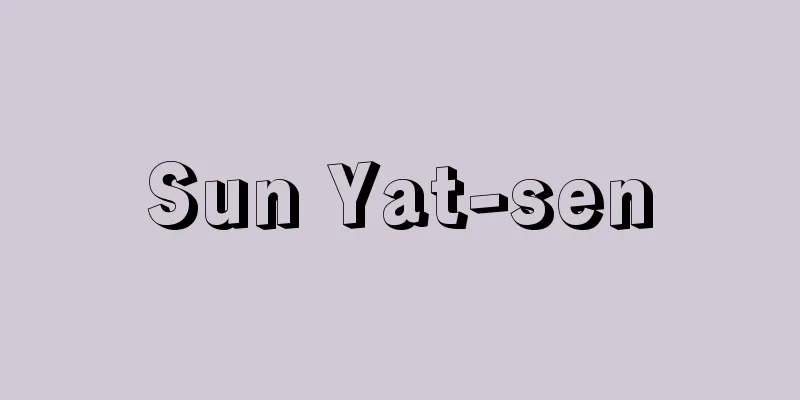Sun Yat-sen

|
A pioneer of the Chinese Revolution. He founded the republic and was called the Father of the Nation. He is known overseas by his pen name, Yixian, and in China by his pen name, Zhongshan. He was born as the second son of a poor farming family in Xiangshan (Zhongshan) County, Guangdong Province. At the age of 14, he went to live with his older brother Sun Mei (1854-1915), who had made a fortune in Hawaii, and studied at a Christian school, acquiring a basic knowledge of Western culture through English from the very beginning, while also acquiring the habit of holding a Bible in his hands. He returned to China at the age of 18, was baptized in Hong Kong, and met Cheng Sir Leung (1863-1901), leader of the Triads, at a medical school in Guangzhou. While studying at the Western Medical College in Hong Kong from 1887 to 1892, he aspired to be a revolutionary, and in 1892 opened a medical practice in Macau and Guangzhou, at the same time joining the anti-Qing movement. In 1894, during the First Sino-Japanese War, he organized the Revival of China Society in Hawaii with the support of his brother, Sun Mei, and others, and joined forces with overseas Chinese and the Huidang Party. In October 1895, he attempted the first uprising in Guangzhou, but failed. He defected to Japan, cut his pigtail, dressed in Western clothing, and traveled to London via Hawaii in 1896. He was captured by the Qing embassy in London, but was rescued by his former teacher James Cantlie (1851-1926) and others from his time at the Saii Shoin School, and became known to the world for his English book, Record of the Persecution in London. He broadened his horizons during his stay in England, awakening to the social contradictions of developed Western countries, and inspired what would later become the Three Principles of the People. He came to Japan via the United States in 1897 (Meiji 30) and became acquainted with Miyazaki Toten (Torazo) and others. He attempted to form an alliance with Kang Youwei and others and to assist in the independence of the Philippines, but both attempts failed. In 1900 he attempted a second uprising (the Huizhou Incident), but this also ended in failure. During Sun Yat-sen's second world trip, the number of students studying in Japan increased and their revolutionary tendencies advanced, but revolutionary organizations such as the Guangfu Society and the Huaxing Society were also born within China. In 1905 (Meiji 38), near the end of the Russo-Japanese War, Sun Yat-sen came to Japan and united various revolutionary factions in Tokyo to form the China Tongxing Society, which established the Three Principles of the People and revolutionary strategies, but after this, leading up to the Xinhai Revolution, there were 10 armed uprisings against the Qing Dynasty in various parts of central and southern China. During this time, Sun Yat-sen attempted his third and fourth world trips, and in October 1911, while in the United States to raise military funds, he learned of the outbreak of the Xinhai Revolution, and toured Western Europe in the hope of receiving assistance from the great powers before returning to China. He was recommended as Provisional President and founded the Republic of China on January 1, 1912, but soon after the North-South Peace Agreement was signed and power was handed over to Yuan Shikai. He aimed for social reform, but was defeated in the Second Revolution triggered by the assassination of Song Jiaoren, and fled to Japan and founded the Chinese Revolutionary Party. It was during this time that he remarried Soong Ching Ling. In the midst of a state of chaos between warlords after the fall of Yuan Shikai in the Third Revolution, he launched a movement to protect the law and once again tried to establish a government centered in Guangzhou. After many setbacks, he came to understand that imperialism was behind the warlords and that he must join with the people in the anti-imperial, anti-warlord struggle, and he learned from the Russian Revolution. In January 1924, he reorganized the Kuomintang and formed an alliance with the Chinese Communist Party (Kuomintang-Communist cooperation), and decided to unite workers and peasants and promote a national revolution. In November, he declared that he would move north and set off on his way north, stopping in Japan to give a lecture entitled "Greater Asianism," and then went to Beijing to hold a national conference, but died in Beijing on March 12, leaving a message that "the revolution is not yet complete." In 1929, his remains were moved from Xishan near Beijing to the Sun Yat-sen Mausoleum on the outskirts of Nanjing. [Yutaka Nozawa March 18, 2016] Political thoughtSun Yat-sen's political ideology is represented by the Three Principles of the People, which inherited the revolutionary tradition of the Taiping Heavenly Kingdom, and incorporated 19th century natural science (theory of evolution), French revolutionary ideas (theory of popular sovereignty), and British social theory (Henry George's theory of single taxation, etc.), adapting them to the realities of China. It aimed to achieve national independence, respect for human rights, and social equality. In his later years, this developed into three major policies: alliance with the Soviet Union, pro-communism, and assistance to workers and peasants, which Mao Zedong and others inherited as the basic principles of new democracy. As shown by ideas such as "capital restraint, he who tills the fields owns his own field," this was a revolutionary theory in a developing country at the imperialist stage, and was particularly opposed to privileges and monopolies. [Yutaka Nozawa March 18, 2016] "The Three Principles of the People (excerpts) and others," translated by Shimada Kenji et al. (2006, Chuko Classics)" ▽ "A Study of Sun Yat-sen, by Fujii Shozo (1966, Keiso Shobo)" ▽ "Sun Yat-sen and Yuan Shikai: Dreams of Chinese Unification, by Yokoyama Hiroaki (1996, Iwanami Shoten)" ▽ "Sun Yat-sen and the Chinese Revolution, by Nozawa Yutaka (Iwanami Shinsho)" ▽ "Sun Yat-sen, Volumes 1 and 2, by Chen Shunshin (Chuko Bunko)" ReferenceSource: Shogakukan Encyclopedia Nipponica About Encyclopedia Nipponica Information | Legend |
|
中国革命の先覚者。共和制を創始して国父と称された。海外では、その号の逸仙(いっせん)で知られ、中国では中山の号でよばれている。 広東(カントン)省香山(中山)県の貧しい農家の次男として生まれる。ハワイで財をなした兄、孫眉(そんび)(1854―1915)のもとに14歳のときに赴き、キリスト教系の学校に学んで、英語を通して欧米文化の基礎的知識を初歩から体得すると同時に、聖書を手にする習慣を身につけた。18歳のときに帰国して、香港(ホンコン)で洗礼を受け、広州の医学校で三合会首領の鄭士良(ていしりょう)(1863―1901)と相知った。1887~1892年香港の西医書院に在学中に革命を志し、1892年マカオ、広州で開業し、同時に反清(はんしん)運動に入った。1894年、日清(にっしん)戦争に際して、兄、孫眉らの支持の下にハワイで興中会を組織し、華僑(かきょう)や会党と組み、翌1895年10月に広州で最初の挙兵を試みるが失敗に終わっている。日本に亡命し、弁髪を切って洋装し、1896年ハワイを経てロンドンに赴いた。ロンドンで清国公使館に捕らわれたが、西医書院在学時の旧師カントリーJames Cantlie(1851―1926)らに救出され、『ロンドン被難記』を英文で著して世に知られた。イギリス滞在中に見聞を広め、欧米先進国の社会的矛盾に目覚め、後の三民主義の着想を得ている。1897年(明治30)アメリカを経て来日し、宮崎滔天(みやざきとうてん)(寅蔵(とらぞう))らと交わり、康有為(こうゆうい)らとの提携や、フィリピン独立援助を試みたが、ともに失敗し、1900年に第2回の挙兵(恵州事件)を試みたものの、同様に失敗に終わっている。 孫文が第2回目の世界旅行を行う間に、留日学生が増加し、その革命化が進んだが、中国国内でも光復会や華興会などの革命組織が生まれていた。1905年(明治38)日露戦争も終わりに近いころ、来日した孫文は東京で革命諸派を合して中国同盟会を結成し、三民主義や革命方略を定めたが、こののち辛亥(しんがい)革命にかけて、中国中・南部の各地で10回に上る反清武装蜂起(ほうき)が反復された。この間、孫文は、第3・第4回目の世界旅行を試み、1911年10月に軍資金の募集でアメリカにいて辛亥革命の勃発(ぼっぱつ)を知り、列強の援助を期待して西欧を巡り、帰国した。臨時大総統に推されて、1912年1月1日中華民国を発足させたが、まもなく南北和議により政権を袁世凱(えんせいがい)に渡した。社会改革を志向したが、宋教仁(そうきょうじん)暗殺事件を契機とする第二革命に敗れて日本に亡命、中華革命党をたてた。宋慶齢(そうけいれい)と再婚したのも、この間のことである。第三革命で袁世凱が倒れたあとの軍閥混戦状態の下で、護法運動を起こし、三たび広州を中心に政権の樹立に努めた。幾多の挫折(ざせつ)を経て、軍閥の背後に帝国主義があり、人民と結合して反帝反軍閥の戦いを進めねばならないことを知り、ロシア革命に学んだ。1924年1月、中国国民党を改組して、中国共産党と提携(国共合作)し、労働者、農民の結集を図って、国民革命を推進することとした。11月、北上宣言を発して北上の途にのぼり、日本に立ち寄って、「大アジア主義」と題された講演を行い、国民会議を開催するため北京(ペキン)に入ったが、「革命いまだならず」と遺嘱して3月12日北京に客死した。1929年遺骸は北京近郊の西山から、南京郊外の中山陵に移葬された。 [野澤 豊 2016年3月18日] 政治思想孫文の政治思想は三民主義をもって代表されるが、それは太平天国の革命的伝統を受け継ぎ、19世紀の自然科学(進化論)、フランスの革命思想(人民主権説)、イギリスの社会学説(ヘンリー・ジョージの単税論など)を取り入れ、中国の現実に適合させたものであり、民族の独立と、人権の尊重、および社会的平等の実現を目ざしていた。晩年には、連ソ・容共・工農扶助の三大政策へと発展を遂げ、毛沢東(もうたくとう)らはこれを新民主主義の基本理念として継承した。それは「資本の節制、耕す者が其(その)田を有す」などといった考えにも示されているように、帝国主義段階の後進国における革命理論として、とりわけ特権と独占に反対するものであった。 [野澤 豊 2016年3月18日] 『島田虔次他訳『三民主義(抄)ほか』(2006・中公クラシックス)』▽『藤井昇三著『孫文の研究』(1966・勁草書房)』▽『横山宏章著『孫文と袁世凱――中華統合の夢』(1996・岩波書店)』▽『野澤豊著『孫文と中国革命』(岩波新書)』▽『陳舜臣著『孫文』上下(中公文庫)』 [参照項目] | | | | | | | | | |出典 小学館 日本大百科全書(ニッポニカ)日本大百科全書(ニッポニカ)について 情報 | 凡例 |
<<: Son Pyŏng-hi (English spelling)
Recommend
Capacitance type electric blood pressure monitor
… [Electronic sphygmomanometer] In the direct met...
Contact
… Caution: A warning. Contact: An order to get cl...
Ebro [river] - Ebro
A large river in northeastern Spain. It originates...
Ormandy, Eugen
Born: November 18, 1899, Budapest [Died] March 12,...
Crown shelf - It's a crown
〘Noun〙① A shelf for placing crowns. Later it was a...
Strasbourg Cathedral - Sutrasuburudaiseido (English name) Cathédrale Notre-Dame de Strasbourg
Strasbourg is a cathedral (church with a bishop&#...
The Human Pavilion Incident
From March to July 1903 (Meiji 36), a show tent ca...
Kangajutsu - Kangajutsu
... The shape of the forehead can be used to infe...
LCC (ship) - LCC
…(e) Enhanced communications and combat informati...
Grater - Oroshigane
…The tool for making oroshi appears in the “Nippo...
Six Dynasties
[1] A general term for the six dynasties ( 222-589...
Imiaki - Imiaki
...The mourning period for childbirth is most sev...
house mosquito
...A general term for insects belonging to the Cu...
Akane (insect) - Akane
…There are many dragonflies with red bodies, but ...
Troglodytes troglodytes (English spelling) Troglodytestroglodytes
…There are about 60 species distributed in Europe...









